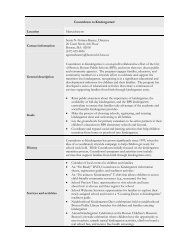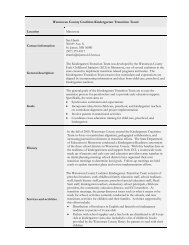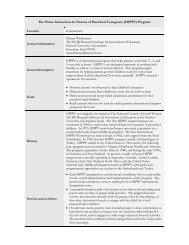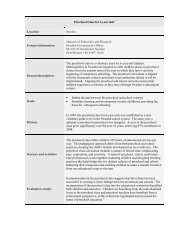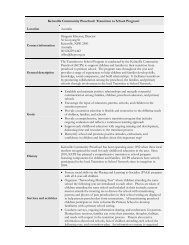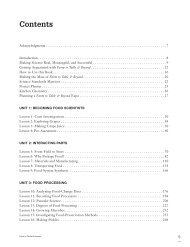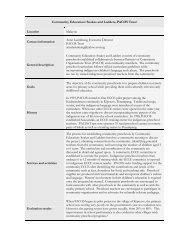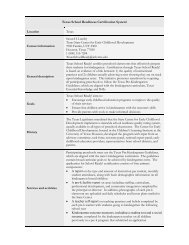Proceedings of the Fourth Annual Teachers College Educational ...
Proceedings of the Fourth Annual Teachers College Educational ...
Proceedings of the Fourth Annual Teachers College Educational ...
You also want an ePaper? Increase the reach of your titles
YUMPU automatically turns print PDFs into web optimized ePapers that Google loves.
“dangerous or violent behavior.” It is measured on a scale <strong>of</strong> Level 4 out <strong>of</strong> 5 levels <strong>of</strong> infractions, higher<br />
levels denoting worse behavior. This language “[e]ngaging in intimidating and bullying behavior, including<br />
cyber-bullying” appears to equate actual/physical bullying with virtual/cyberbullying. Students spend more<br />
time online, equivalency appears prudent. Protecting staff is also important given <strong>the</strong> ease with which<br />
questionable virtual behavior can become public and have real-world lasting effects.<br />
Disciplinary responses are wide: parent conference, in-school disciplinary actions, removal from <strong>the</strong><br />
classroom by teacher, suspensions by principals and superintendents as well as expulsion (Discipline<br />
Code, 2010, p. 22). This diverse list implicitly acknowledges <strong>the</strong> variety <strong>of</strong> cyberbullying, allowing tailoring<br />
<strong>of</strong> punishment.<br />
New York State<br />
The Dignity for All Students Act (2009) is a similarly well-balanced piece <strong>of</strong> legislation, protecting multiple<br />
stakeholders. Section 12, subsection 1 states “[n]o student shall be subjected to harassment by<br />
employees or students on school property or at a school function; nor shall any student be subjected to<br />
discrimination based on a person’s actual or perceived race, color, weight, national origin, ethnic group,<br />
religion, religious practice, disability, sexual orientation, gender, or sex by school employees or students<br />
on school property or at a school function” (Dignity for All Students Act, 2009). Due to this general<br />
definition <strong>of</strong> “bullying,” “cyberbullying,” a specific subset <strong>of</strong> bullying behavior is presumably covered. Any<br />
student subjected to <strong>the</strong>se enumerated types <strong>of</strong> discrimination through electronic means would be<br />
afforded similar protection.<br />
Unfortunately, <strong>the</strong> term “cyberbullying” is not included in this Act. This could prove problematic in litigation<br />
since <strong>the</strong> aggrieved would presumably have to prove cyberbullying is a form <strong>of</strong> bullying and benefit from<br />
its protection.<br />
Common Law<br />
Common law has been inconsistent in its application <strong>of</strong> <strong>the</strong> First Amendment to <strong>of</strong>f-campus speech<br />
regarding social networking sites, at least at <strong>the</strong> Federal Court <strong>of</strong> Appeals. Conflicting decisions in<br />
Layshock (2011) and Blue Mountain (2011) led <strong>the</strong> Third Circuit to vacate <strong>the</strong>se differing opinions. Upon<br />
reconsideration <strong>the</strong>y held that <strong>the</strong> Fraser (1978) standard only applied to on-campus speech and that <strong>the</strong><br />
Tinker (1969) standard applied to <strong>of</strong>f-campus speech (Sneed et al., 2011) - regulating <strong>of</strong>f-campus speech<br />
can only occur if <strong>the</strong>re is a reasonable likelihood that <strong>the</strong> speech in question will have a material and<br />
substantial disruption at <strong>the</strong> school in question (Sneed et al., 2011). Cases outside <strong>the</strong> Third Circuit will<br />
clarify <strong>the</strong> disruption necessary to limit <strong>of</strong>f-campus speech.<br />
Non-Legal Considerations<br />
Limit <strong>of</strong> Locally-Created Acceptable Use Policies<br />
Given my previous experiences as a teacher in Canada and <strong>the</strong> United Kingdom as well as a researcher<br />
in New York schools, I appreciate educator demands in <strong>the</strong> public system. Given <strong>the</strong> time and care<br />
necessary to draft legally-sound Acceptable Use Policies (AUP), I believe that writing <strong>the</strong>se on anything<br />
smaller than a school-district scale by licensed lawyers invites <strong>the</strong> potential for needless litigation in terms<br />
<strong>of</strong> <strong>the</strong> AUP being ei<strong>the</strong>r too stifling in prohibiting or loose in allowing behavior. However, a town hall-type<br />
discussion <strong>of</strong> <strong>the</strong> language <strong>of</strong> <strong>the</strong> AUP, <strong>the</strong> legal-political-social-educational-technological context that<br />
necessitated its creation, and <strong>the</strong> need for administrators, teachers, parents and students to be vigilant in<br />
its application, is prudent.<br />
The Virtual v. The Real<br />
Social media plays an increasing role in communications. Educators must help students appreciate <strong>the</strong><br />
costs <strong>of</strong> using networked communication insensitively. Cognitive development involves an understanding<br />
<strong>of</strong> <strong>the</strong> differentiation between <strong>the</strong> physical/real versus <strong>the</strong> abstract/virtual. Too many students have<br />
insufficient understanding <strong>of</strong> <strong>the</strong>se differences, especially in terms <strong>of</strong> <strong>the</strong> real-world costs <strong>of</strong> imprudent<br />
virtual behavior. Educators must be involved in this important, but sensitive, area.<br />
65



